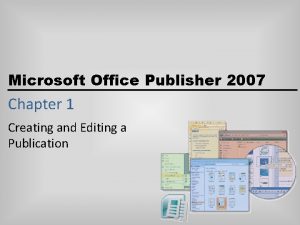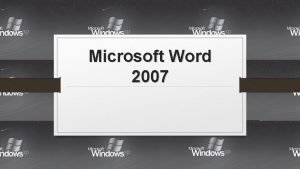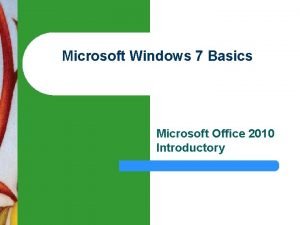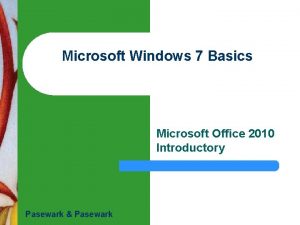Microsoft Office 2007 Illustrated Introductory Windows Vista Edition


































- Slides: 34

Microsoft Office 2007 - Illustrated Introductory, Windows Vista Edition Formatting a Worksheet

Objectives • • • Format values Change font and font size Change attributes and alignment Adjust column width Insert and delete rows and columns Microsoft Office 2007 -Illustrated Introductory, Windows Vista Edition

Objectives • • Apply colors, patterns, and borders Apply conditional formatting Name and move a sheet Check spelling Microsoft Office 2007 -Illustrated Introductory, Windows Vista Edition

Formatting Values • The format of a cell determines how the labels and values look • Bold, italic, dollar signs, commas, etc. • Formatting does not change the data only its appearance • Select a cell or a range, then apply formatting Microsoft Office 2007 -Illustrated Introductory, Windows Vista Edition

Formatting Values Format Cells dialog box Microsoft Office 2007 -Illustrated Introductory, Windows Vista Edition

Changing Font and Font Sizes • A font is the name for a collection of characters with a similar, specific design • Font size is the physical size of text • Measured in points • 1 point = 1/72 of an inch • The default font in Excel is 11 -point Calibri Microsoft Office 2007 -Illustrated Introductory, Windows Vista Edition

Changing Font and Font Sizes Font tab in the Format Cells dialog box Currently selected font Type a custom font size or select from the list Font style options Preview area Microsoft Office 2007 -Illustrated Introductory, Windows Vista Edition

Changing Font and Font Sizes Worksheet with formatted title and labels Font and size of active cell or range Microsoft Office 2007 -Illustrated Introductory, Windows Vista Edition

Changing Attributes and Alignment • Attributes are styling formats such as bold, italics, and underlining • The Format Painter allows you to copy all formatting attributes of selected cells and apply them to other cells • Use to copy multiple format settings or individual ones Microsoft Office 2007 -Illustrated Introductory, Windows Vista Edition

Changing Attributes and Alignment • Alignment determines the position of data in a cell • Left, right, or center • Apply attributes and alignment options using: • • • Home tab, or Format Cells dialog box, or Mini toolbar Microsoft Office 2007 -Illustrated Introductory, Windows Vista Edition

Changing Attributes and Alignment Worksheet with formatting attributes applied Formatting buttons selected Title centered across columns Center button Merge & Center button Column headings centered, bold, and underlined Microsoft Office 2007 -Illustrated Introductory, Windows Vista Edition

Changing Attributes and Alignment Common attribute and alignment buttons Microsoft Office 2007 -Illustrated Introductory, Windows Vista Edition

Adjusting Column Width • Adjust column widths to accommodate data • Default column width is 8. 43 characters wide (a little less than one inch) • One or more columns can be adjusted using the mouse, the Ribbon, or the shortcut menu Microsoft Office 2007 -Illustrated Introductory, Windows Vista Edition

Adjusting Column Width • Column heading is the box at the top of each column containing a letter • Changing a column width with the mouse • Position the mouse pointer between the column headings of the column and the column to its right • Click and drag the resize pointer to the right Microsoft Office 2007 -Illustrated Introductory, Windows Vista Edition

Adjusting Column Width • Using the Auto. Fit feature • Position the mouse pointer between the column headings of the column and the column to its right • Double-click to activate the Auto. Fit feature Microsoft Office 2007 -Illustrated Introductory, Windows Vista Edition

Adjusting Column Width Preparing to change the column width Resize pointer Click to change column or row formatting Microsoft Office 2007 -Illustrated Introductory, Windows Vista Edition

Inserting and Deleting Rows and Columns • When you insert a new row, the contents of the worksheet shift down from the newly inserted row • When you insert a new column, the contents of the worksheet shift to the right of the new column • Excel inserts rows above the cell pointer and columns to the left Microsoft Office 2007 -Illustrated Introductory, Windows Vista Edition

Inserting and Deleting Rows and Columns Insert dialog box Entire row option button Microsoft Office 2007 -Illustrated Introductory, Windows Vista Edition

Inserting and Deleting Rows and Columns • Deleting rows and columns • Select the row or column heading • Click the Delete button in the Cells group or use the Delete command on the shortcut menu Microsoft Office 2007 -Illustrated Introductory, Windows Vista Edition

Applying Colors, Patterns, and Borders • You can add enhancements such as colors, patterns, and borders by using: • Border and Fill Color buttons in the Font group on the Home tab of the Ribbon and on the Mini toolbar, or • Fill tab and Border tab in the Format Cells dialog box Microsoft Office 2007 -Illustrated Introductory, Windows Vista Edition

Applying Colors, Patterns, and Borders • Cell styles are pre-designed combinations of formatting attributes • Use the Cell Styles button in the Styles group on the Home tab Microsoft Office 2007 -Illustrated Introductory, Windows Vista Edition

Applying Colors, Patterns, and Borders Viewing fill color using Live. Preview Cell styles button Font color list arrow Cell A 1 with light blue background Microsoft Office 2007 -Illustrated Introductory, Windows Vista Edition

Applying Conditional Formatting • Excel can format cells based on specific results • Automatic application of formatting attributes on cell values is called conditional formatting • For example: values above a certain number can be one color and values below a certain number can be another color Microsoft Office 2007 -Illustrated Introductory, Windows Vista Edition

Applying Conditional Formatting • To apply conditional formatting: • Click Conditional Formatting button in the Styles group on the Home tab • Point to Highlight Cells Rules, and then choose from “Between”, “Greater Than”, “Less Than”, etc. • Define conditions and formatting in the dialog box that opens Microsoft Office 2007 -Illustrated Introductory, Windows Vista Edition

Applying Conditional Formatting • Data bars are a type of conditional formatting that visually illustrate differences among values • Click the Conditional Formatting button in the Styles group, point to Data Bars, and then choose from a formatting Microsoft Office 2007 -Illustrated Introductory, Windows Vista Edition

Applying Conditional Formatting Previewing a Data Bar Data bars Microsoft Office 2007 -Illustrated Introductory, Windows Vista Edition

Applying Conditional Formatting Results of Conditional Formatting Microsoft Office 2007 -Illustrated Introductory, Windows Vista Edition

Naming and Moving a Sheet • By default, an Excel workbook initially contains three worksheets, named Sheet 1, Sheet 2, and Sheet 3 • To move to another sheet, click its sheet tab • To make it easier to identify the sheets, you can rename each sheet and add color to the tabs Microsoft Office 2007 -Illustrated Introductory, Windows Vista Edition

Naming and Moving a Sheet • To rename a sheet, double-click its sheet tab, type the new name, and then press [Enter] • To add color to a sheet tab, right-click the sheet tab, point to Tab Color, and then choose a color • You can change the order of sheets by dragging the sheet tabs Microsoft Office 2007 -Illustrated Introductory, Windows Vista Edition

Naming and Moving a Sheet during move Sheet relocation pointer Sheet 1 renamed Indicates tab color Microsoft Office 2007 -Illustrated Introductory, Windows Vista Edition

Checking Spelling • Spelling checker scans the worksheet and flags possible mistakes and suggests corrections • To check other worksheets in a workbook, display the worksheet and run the spelling checker again • Add words that are spelled correctly but are not recognized by the spelling checker Microsoft Office 2007 -Illustrated Introductory, Windows Vista Edition

Checking Spelling: English dialog box Misspelled word Replacement word suggestions Microsoft Office 2007 -Illustrated Introductory, Windows Vista Edition

Summary • • • Format values Change font and font size Change attributes and alignment Adjust column width Insert and delete rows and columns Microsoft Office 2007 -Illustrated Introductory, Windows Vista Edition

Summary • • Apply colors, patterns, and borders Apply conditional formatting Name and move a sheet Check spelling Microsoft Office 2007 -Illustrated Introductory, Windows Vista Edition
 Ipseq
Ipseq Microsoft office visio professional 2007
Microsoft office visio professional 2007 Office project 2007
Office project 2007 Ms publisher 2007
Ms publisher 2007 Office live meeting 2007
Office live meeting 2007 Microsoft office 2007 wikipedia
Microsoft office 2007 wikipedia Microsoft office groove 2007
Microsoft office groove 2007 Proyecciones en sistema europeo y americano
Proyecciones en sistema europeo y americano Microsoft windows movie maker
Microsoft windows movie maker Introductory chemistry 4th edition
Introductory chemistry 4th edition Prefix multipliers
Prefix multipliers Introductory chemistry 5th edition answers
Introductory chemistry 5th edition answers Microsoft windows office rajesh
Microsoft windows office rajesh Windows vista kernel
Windows vista kernel Logotipo de windows vista
Logotipo de windows vista Certified for windows vista
Certified for windows vista Bluetooth windows vista
Bluetooth windows vista Vista system requirements
Vista system requirements Windows 7 codename
Windows 7 codename Hello windows vista
Hello windows vista Windows vista sdk
Windows vista sdk Windows vista
Windows vista Windows vista je
Windows vista je Windows vista ui
Windows vista ui Window to window chapter 30
Window to window chapter 30 Windows vista disk management
Windows vista disk management Windows vista kernel extension
Windows vista kernel extension Vista windows kenya
Vista windows kenya Vista user account control
Vista user account control Windows vista tour
Windows vista tour Windows vista logo
Windows vista logo Net framework windows vista 32 bit
Net framework windows vista 32 bit Deshabilitar vista protegida office 2016
Deshabilitar vista protegida office 2016 Biochemistry sixth edition
Biochemistry sixth edition Tombol size button terletak di bagian pojok
Tombol size button terletak di bagian pojok
























































